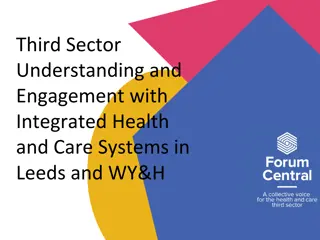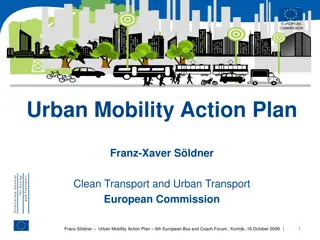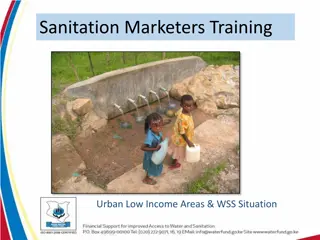Contrasting Urban Challenges in Leeds and Mumbai
Wealth inequality and urban challenges present contrasting pictures in Leeds, England, and Mumbai, India. While Leeds boasts wealthy suburbs and sustainability initiatives, Mumbai grapples with housing shortages, slum development, water supply issues, and air pollution. The two cities showcase the complexities of urbanization, from global city status to poverty and deprivation in slum areas.
Download Presentation

Please find below an Image/Link to download the presentation.
The content on the website is provided AS IS for your information and personal use only. It may not be sold, licensed, or shared on other websites without obtaining consent from the author.If you encounter any issues during the download, it is possible that the publisher has removed the file from their server.
You are allowed to download the files provided on this website for personal or commercial use, subject to the condition that they are used lawfully. All files are the property of their respective owners.
The content on the website is provided AS IS for your information and personal use only. It may not be sold, licensed, or shared on other websites without obtaining consent from the author.
E N D
Presentation Transcript
Current challenges Inequality of wealth. Sydney is a city with wealthy suburbs, particularly in north Leeds (e.g. Alwoodley 83% home ownership). Leeds also has poor suburbs where people live in poverty (e.g. Little London 33% home ownership). Poverty e.g. Little London, a poor inner city suburb in Leeds. Higher levels of unemployment, lots of 1970s social housing e.g. tower blocks for low income families (33% home ownership). Transport. Traffic congestion can be a problem e.g. A647 Leeds Ring Road. Strategies: Elland Road park & ride Leeds cycle superhighway A647 2+ person lanes 1.1 Urbanisation in contrasting global cities Year Population Urbanisation the growth of cities due to migration & natural increase. Urbanisation tends to be more rapid in LICs Global city a large city with important links to other parts of the world e.g. London, Shanghai Re-urbanisation increasing population in city centre areas. Linked to redevelopment of old and run down city area e.g. Greenhouse Leeds. 2011 751,000 2001 715,000 HIC Global City HIC Global City Leeds, England Leeds, West Yorkshire, northern England. Evidence for Leeds as a global city. HQs of international organisations e.g. Jet2 airline, GHD hair straighteners, ASDA Walmart UK. International & national transport. E.g. Leeds-Bradford airport, M1 & M62 motorways, international port of Hull. Universities with international students & staff e.g. Leeds University, Leeds Beckett University. International festivals e.g. Leeds West Indian Carnival. >20 different languages spoken in Leeds. Leeds, England Creating sustainable urban environments Greenhouse , Beeston, Leeds. A sustainable, multi-purpose community. Location Beeston, 0.5 miles south of Leeds CBD. Examples of sustainability in Greenhouse : Brownfield site development re-used a derelict site. Transport Hub Greenhouse has excellent public transport connections walk to Leeds train station, local bus stops, free bike hire. Recycling of water (e.g. rainwater) for toilet flushing, watering plants etc Rooftop garden and green spaces Clean energy e.g. wind turbines, solar panels, ground source heating. Pull factors to Sydney from other parts of UK. Excellent universities for young people e.g. Leeds University, Leeds Beckett University More job opportunities than rural UK e.g. banking & finance, education & health e.g. LGI & St James Hospitals Exciting city life. E.g. Leeds Rhinos, Yorkshire Cricket, Leeds Utd. Pull factors to Leeds from other countries (international migration) High standard of living in HIC global city English speaking e.g. migrants from Ireland, Australia Job opportunities e.g. business, finance, education Nearby countries in Europe e.g. France, Spain, Ireland, Poland.
Current challenges Housing shortages and slum development Due to Mumbai s dramatic increase in population there is a massive housing shortage. Most residents put up with very poor housing. Many live in cramped, poor quality, expensive rooms, far from work. Many residents are forced into slums over time, they buy scrap materials to build a home. Water supply and waste disposal Only better-off suburbs have private water supplies. 60% of Mumbai s population uses communal taps. In some slums, water only runs for 30 minutes day. Rapid urbanisation has also caused uncontrolled water pollution. Factories use the Mithi River to dump untreated waste. 800 Million litres of untreated sewage go into the river every day. Dealing with air pollution traffic Traffic congestion is legendary in India with not enough money being spent on roads. There are too few suburban train and bus networks to meet demand. 3500 people die on Mumbai s railway each year. Most deaths are caused by passengers crossing tracks, sitting on train roofs and being electrocuted by overhead cables, or hanging from doors and windows. Poverty and deprivation (Dharavi example) People have to go to the toilet in the street and there are open sewers. Doctors deal with 4,000 cases a day of diphtheria and typhoid. Next to the open sewers are water pipes, which can crack and take in sewage. Dharavi slum is based around this water pipe built on an old rubbish tip. The people have not planned this settlement and have no legal rights to the land. There are also toxic wastes in the slum including hugely dangerous heavy metals. NIC Global City NIC Global City Mumbai, India Reasons for growth 38% of migrants to Mumbai come from Maharashtra state. Maharashtra state is more rural than Mumbai and half of the population works in farming. Increased use of machinery has forced people out of work, and changes to farming have forced people with small farms to sell up to larger land owners. Small scale farmers are also vulnerable to bad harvests and poor weather. In bad years, they can end up forced to sell up and have to migrate. Mumbai - job opportunities in service industries and the manufacturing industries with higher wages. Schools, health care facilities and entertainment more in Mumbai than other parts of Maharashtra state. Mumbai, India Recent changes in Population in Mumbai 6 Population (millions) 5 4 3 2 1 0 Population Increase (millions) Natural Increase (Millions) Net Migration (Millions) 1991-2001 3.48 1.51 1.97 2001-2011 4.98 1.86 3.08 Improving lives Slum clearance programmes Bulldozing the slums and rebuilding them elsewhere (e.g. Bhendi Bazaar) Self-help schemes Housing building materials are provided for local people to help improve the buildings in their community Loans - low interest loans allow investment e.g. new machines for business Mass transit Using more modern trains more ecofriendly. Improve train services by improving ventilation on carriages and extending the length of platforms. Small scale industry and recycling Dharavi s recycling Many materials are recycled and used to construct buildings. 80% of Mumbai s waste is recycled (local informal economy). Resulting ways of life Mumbai is one of the richest cities in Asia but also home to some of the world s poorest people. 6% of India's GDP, 40 % of foreign trade, and 25% of industrial production. Its per-capita income is higher than the national average. It is the entertainment, fashion and commercial centre of India, being the birthplace of Bollywood. One of the world's top 10 centres of commerce in terms of global financial flow. It also has the headquarters of a number of Indian financial institutions e.g. Bombay Stock Exchange and the Reserve Bank of India, and numerous Indian companies such as the Tata Group. Many foreign companies also have their branches in the South Bombay area. Mumbai is the world's 29th largest city by GDP.
Distinctive features of Leeds 1.2 Urban and rural processes and change in the UK Leeds and the Burgess Model CBD - Flagship stores and national chain outlets will locate their businesses (e.g. Trinity and the city centre). Key Terms Urbanisation an increase in the proportion of people living in urban areas compared to rural areas. Inner city - E.g. Little London or Hyde Park Found just outside the CBD. Old terraced houses and high rise blocks, grid or grid iron street pattern. Old factories. Suburbanisation an increase in the number of people loving to live in suburbs Inner suburbs E.g. Headingley. Semi-detached houses with small gardens. Local shopping centres (e.g. Headingley Arndale). Counter-urbanisation whenmore and more people choosing to live on the edge of urban areas - with many relocating to the countryside. Outer suburbs E.g. Bramhope. Lots of detached houses, space, greenery on the edge of the city. Re-urbanisation the movement of people back into an area that has been previously abandoned due to problems such as pollution, overpopulation, inadequate housing, etc. arise. Urban-rural fringe E.g. Pool in Wharfedale. In the countryside but commutable to city centre. Infill the use of vacant land and property within a built- up area for further construction or development. Alwoodley and Little London comparing a zone of affluence and zone of deprivation in Leeds. Greenfield site a site which has never been built on before Alwoodley Little London Brownfield site re-using a site that has been built on 85% home ownership 33% home ownership Greenbelt land protected from new building around the edge of a city 0% more than one person per room 32% more than one person per room Zone of affluence an area that is wealthy and people have a high quality of life More households have more than 2 cars in Alwoodley More people have no cars in little London. Quality of life is higher Quality of life is lower Zone of deprivation an area where income levels are lower and quality of life is lower Greenhouse, Leeds Example of a sustainable, multi-purpose, sustainable community. Shows re-urbanisation and use of brownfield sites in Leeds as it involves the refurbishment of a redundant 1930s hostel in South Leeds and encouraged people to move back into the area. Sustainability use of ground source heat pumps for electricity and heating. Affordably priced to buy/rent. Facilities Allotments, Bicycle Club, Deli, Gymnasium, Renewable Energy.
Changing Retail Provision Shops want to be where lots of customers can reach them easily. As more and more households got cars more out-of- town shopping malls were built. The White Rose Centre, Leeds, is a local example, opened in 1997. In 2013 Trinity Centre was built in Leeds (an example of re-urbanisation), to try attract customers back to the CBD. Leisure use in rural and urban UK Honeypot sites: Tourist sites that attract the largest numbers of people (e.g. Malham) because they are: Exceptionally beautiful or interesting Accessible by road and within easy reach of people living in larger towns or cities Convenience goods (low-order goods) - We buy them regularly. We usually buy them from local shops or supermarkets wherever is most convenient. Likely to exceed their carrying capacity. This means the ability of a landscape or ecosystem to absorb the activity of people without any lasting damage. Comparison goods (high-order goods) - We spend time choosing these items. We usually will travel to the CBD or Out of town shopping centres for these goods. Will travel further. Examples of urban and rural leisure use Rural Change in the UK Issues created by rural depopulation: Schools close Shops close Pubs close Second home ownership Families can t afford houses Counterurbanisation is taking place at the same time in the UK. Why? Increasing car ownership = more accessible Growth of commuter settelements (e.g. Drighlington) The range of a service or product - the maximum distance that people are prepared to travel for a specific service Urban Rural Cinemas National Parks Threshold population of a good or service - The minimum number of people required to support it. Shopping/retail Hiking & cycling Sports stadiums Horse riding Catchment - the area served by a service such as a school/hospital or shop. Art galleries & museums Fishing Sports centres Extreme sports Case Study: Rugby World Cup in 2015 Positive economic multiplier effect where benefits for local businesses spread, like ripples in a pond, through the local community. Positive effects Negative effects Investment in infrastructure (e.g. transport, stadia) Noise pollution Traffic congestion Direct employment (16,000 for the RWC) and indirect employment Parking issues
International trade Imports goods/materials/services bought into a country Exports goods/materials/services sold overseas Trade bloc a group of countries with trade agreements e.g. EU Tariffs a tax on imports. Designed to make imports more expensive to protect local businesses 1.3 A global perspective on development issues Global patterns of development Development is the wealth and standard of living of a country HIC High income country e.g. UK, Japan NIC Newly industrialised country e.g. Vietnam LIC Low income country e.g. Uganda Human Development Index (HDI) combining GDP per capita, adult literacy rate and life expectancy to give a value between 0 and 1 Brandt line divides the rich north from the poor south of the world Life expectancy average number of years population lives to Birth rate number of births per 1000 people per year Death rate number of deaths per 1000 people per year Adult literacy rate - % of population that can read & write Advantages of trade: Increased consumer choice Exports can improve an economy Fair and free trade can support LICs and reduce global inequalities e.g. Ben & Jerry s Ice-cream, fair trade vanilla from Uganda (Rwenzori Farmers Cooperative Union). Problems of trade LICs can be exploited with low prices Trade barriers (e.g. tariffs) can stop some countries accessing markets LICs (e.g. Uganda) that mainly export low value agricultural products (e.g. cocoa beans, vanilla) at risk of price changes globally Aid Long term development aid e.g. Water Aid providing aid (e.g. funding toilets & clean water supplies) to Uganda where 24m people lack access to clean water & 4,500 children die due to diarrhoea every year. Emergency short term aid e.g. Red Cross Uganda, 2018 floods Teso region, Uganda. Impacts of Globalisation Positive impacts Negative impacts Globalisation Increasing links between the countries of the world Trade Buying & selling of goods, raw materials & services between countries Migration movement of people between countries Geo-political links political links between countries e.g. EU countries Multi National Company (MNC) company with branches in more than one country e.g. Nike, Apple Better understanding of cultures & religions Wider consumer choice e.g. food from other continents Better world communication Freedom of movement Jobs created globally Aid provided to poorest parts of the world Uneven levels of development e.g. low wages for unskilled work in LICs Air pollution from travel & transport Conflicts due to migration Loss of jobs as production moves from HICs to LICs/NICs
NIC case study Vietnam. Vietnam is in SE Asia, on coast of South China Sea, capital is Hanoi Vietnam GDP per capita has increased at over 6% per year since 1990s HIC case study UK, NW Europe UK is one of the world s most wealthy countries with a high standard of living. GDP per capita US$40,000 In NICs economic growth has been rapid. Also: The manufacturing sector (factories) has grown quickly Urbanisation occurs Lots of trade with other countries (buying & selling) Foreign direct investment by Multinational Companies e.g. Nike Nissan investment in UK by Nissan (a MNC) Head office in Japan Why did Nissan invest in Sunderland, UK? (outsourcing) Access to EU market avoiding tariffs and quotas 100m Enterprise Zone funding Encouraged by UK government e.g. land sold at agricultural prices Excellent transport e.g. A1 and A19, Tyne Port Engineering background of Sunderland Nike investment in Vietnam by Nike (a MNC) Head office Oregon, USA Why did Nike invest in Vietnam? (outsourcing) Access to cheap labour Access to Asian markets Fewer environmental regulations for factories in Vietnam Encouraged by Vietnam government Fewer trade unions and work regulation in Vietnam than USA Fact file: Makes over 400,000 cars per year. Employs over 5000 workers (direct jobs) Has had an additional 2 billion invested on site. The Nissan Leaf has been manufactured at the Nissan car factory in Sunderland from 2013. Benefits for Vietnam Direct jobs Over 340,000 jobs created in Vietnam by Nike Indirect jobs e.g. suppling materials for factories making Nike products Helps to strengthen the economy of Vietnam e.g. taxes paid by MNCs Increased exports by Vietnam Impacts People Economy Environment 5000 direct jobs Indirect jobs e.g. Interplas NE Over 2bn investment from Nissan Over 4m cars exported to Europe Loss of green land - 3 million square metres Problems for Vietnam Environmental pollution by industry Many jobs low wage factory jobs Poor working conditions for workers























